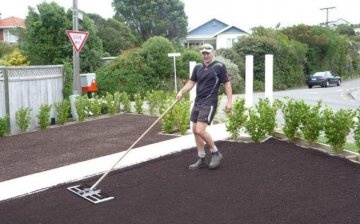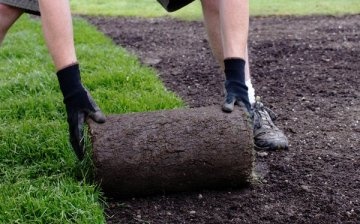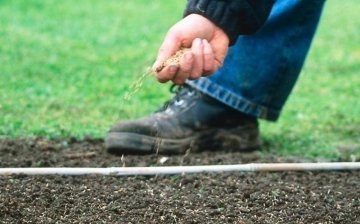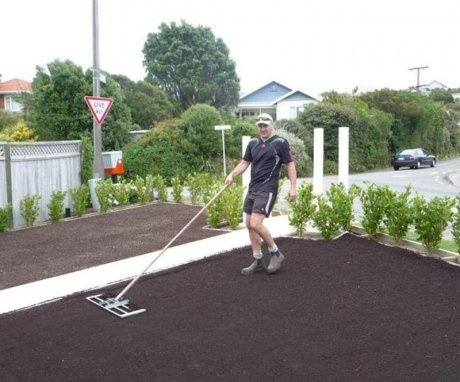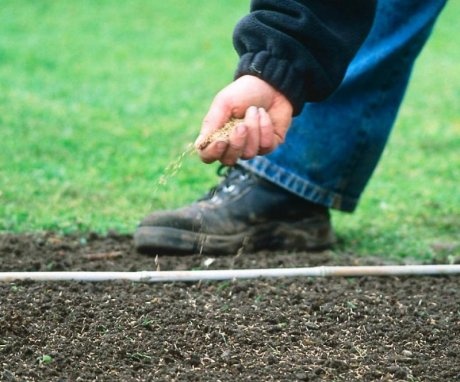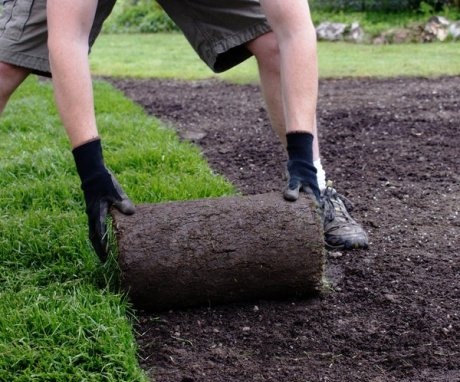DIY step-by-step guide to preparing soil for a lawn
When arranging parks and adjoining territories, a place is allocated for a luxurious lawn. This element of the exterior performs not only an aesthetic function, but also a practical one. Lawn grass cleans the soil from harmful microorganisms, improves the microclimate of the site, and helps to increase air humidity. To obtain a dense green canvas, high-quality preparation of the soil for the lawn is necessary.
Requirements for the area for the lawn
The first step is to determine the place for lawn... Going through different options, it should be borne in mind that the site should be well lit by sunlight.
Advice! When choosing a place for a lawn, you need to take into account what kind of irrigation will be used, its mode of operation. Light shading near the site in the form of tall trees or a fence will not hurt. Otherwise, the scorching rays will burn out the grass.
Another criterion is the side of the world. The microclimate depends on which side the site is located on. If the choice fell on a site located from the east or north, the lawn will be blown by a cold wind, from the west or southwest - damp. The southern direction is fraught with increased dryness, the northern one - too much shade.
In this case, you need to focus on the type of lawn. Cold wind is not dangerous for a flat grass carpet, but excess moisture and deep shade can destroy it. For tall lawn plants, it is better to choose zones that are not blown by the wind, otherwise the appearance will be spoiled due to the grass laid in different directions.
An equally important role in site selection is played by the type of soil and the level of occurrence of groundwater. Too dense soils are lightened by a mixture of peat and sand, loose ones are enriched with fertile soil. With a close occurrence of groundwater, it becomes necessary to arrange a drainage system.
What places are not suitable for the lawn:
- in the lowlands;
- in swampy areas;
- on a relief area with steep slopes;
- in close proximity to tall trees.
Do not despair if the available space for the lawn does not meet the above criteria. By adhering to the rules for preparing the soil for sowing grass, you can correct any flaws and shortcomings.
What is needed to prepare the soil for the lawn with your own hands
When developing landscape design, you should think over the layout for the lawn. If you plan to sow grass on a large area, you need to make smooth slopes (about 30 degrees). This will prevent moisture stagnation after prolonged rainfall.
If the area for the lawn is embossed, you need to plan the site to eliminate abrupt transitions. This step should not be ignored, otherwise the passage of the lawn mower will be difficult.
When initially developing a project, it is important to think over the shape and location of the lawn. The site is chosen taking into account the insolation. Greens develop well in the sun. The shape is chosen at will, the main thing is that there are no sharp corners and zigzags. The complex configuration of the object will complicate the haircut procedure.
In addition to the lawn itself, you need to provide approaches to it, fencing, lighting.
Reference! If you plan to mow using a machine, the paths are arranged below the level of the grass area.
To prepare the soil for your lawn yourself, you need to consider the following factors:
- a place for sowing grass is equipped with a slight slope;
- work is carried out using cultivation equipment and garden tools (a minimum set of inventory will be required when choosing a small site);
- the activities should be carried out according to the planned plan, it is not worth neglecting weeding, digging or compaction, otherwise the efforts will not be crowned with success.
Approximate work plan for soil preparation
- Clearing the site from large debris.
- Digging with the simultaneous selection of weeds with roots, stones, stumps and other plant residues from the soil.
- Increasing soil fertility by applying fertilizer, lightening the soil, neutralizing acidity. In some cases, replacement of the top soil layer (10-15 cm) is required.
- Leveling the pad.
- Weeds weeding for 2-4 weeks. Before sowing, you cannot leave the site unattended.
Experienced gardeners do not advise treating the site with herbicides, especially if the site of the local area is chosen as the place for the lawn.
When to do it
It is better to start preparing a plot for a lawn in the fall. During the cold season, the earth will be compacted, all the flaws and irregularities of the site will be visible. When organizing work in the spring, you should walk on the ground with a hand roller.
The advantages of autumn preparation is the ability to carry out the entire range of recommendations:
- soil analysis to determine its type, fertility;
- alkalinization of acidified soil (introduction of lime powder);
- lightening the high density of the earth (peat, compost and sand are used);
- destruction of weeds by treating the site with chemicals (in spring, sowing after using herbicides is allowed no earlier than 4-5 weeks).
You can prepare the land during any period of the warm season. However, it is not advisable to do this in summer, since before sowing the lawn grass, the area will be covered with a carpet of weeds. The optimal timing of work is autumn, the first months of spring (if climatic conditions permit).
How to properly prepare the soil in stages
Phased soil preparation, taking into account the recommendations of specialists, is the key to high-quality lawn organization work.
Site cleaning and weed removal
Cleaning the site for the object does not inspire everyone. Despite the lack of enthusiasm, this is a significant contribution to a future landscape design project. Garbage, weeds, stones must be removed from the site.
This neighborhood prevents the roots of the lawn grass from developing normally. Weeding is suggested to be done after heavy rains. This is the ideal time for a long weed root system to get out of the ground. In addition, the soil is easily shaken off the root fibers.
For a more thorough cleaning, digging of the soil is required. Do it using a cultivator or an ordinary shovel. The goal is not only to loosen the soil, but also to re-harvest weeds and other debris. Quality work minimizes the risk of a weed carpet overgrowing the lawn.
Advice! Upon completion of digging up the site, it is recommended to walk on it again to remove missed weeds.
Alignment
After the initial digging, the surface of the territory is covered with large fragments of soil. In the absence of rain, they turn into impenetrable cobblestones in a couple of days. Therefore, leveling is carried out immediately after cultivation. The essence of the procedure lies in the passage through the site with a rake. The purpose of the event is to break up the clods to a fraction of wheat grain, to level the drops, mounds.
The whole process of preparing land for a lawn in large areas is carried out with a motor cultivator or walk-behind tractor.
A large board is used to level the surface. It is attached to cables or chains on both sides of an unpretentious device. It remains only to drag the board over the area to trim the tubercles.
Digging
The next step is a thorough digging. This type of work is single-tier and two-tier.The first option is used to cultivate previously cultivated land. If the soil has not been cultivated for a long time, use the second method.
Single-tier digging is performed to the depth of the shovel bayonet. In this case, only the upper soil layer is prepared, the lower one remains the same. Experienced gardeners are advised to combine this process with the introduction of rotted compost or manure.
Features of performing two-tier digging:
- across the site, make a groove for 1 bayonet of a shovel (the earth must be removed to the side for a while);
- loosen the lower soil level with a pitchfork or pickaxe;
- in parallel with the first groove, make a second, fill the removed soil into the first groove;
- to seal the first furrow, take the soil removed from the first groove.
The work is done with great diligence. It is important to break up large clods immediately with a tool, without allowing them to dry out.
Important! Dense clayey terrain requires drainage. You can make a branch system in the process of two-tier digging.
Formation
The correct lawn can have small slopes (up to 30 degrees) with smooth gradients. This will ensure unobstructed passage of the lawn mower, eliminating stagnation of moisture during heavy rains.
During the initial arrangement of the lawn, its shape and place for the object are carefully thought out. When choosing a site, you should give preference to the sunny side. It is better to avoid a complex shape of the perimeter, this will complicate the further maintenance of the lawn grass, especially mowing.
Drainage
The need for drainage arises when processing clayey soils. The dense structure prevents the normal development of the root system of the lawn grass, provokes rotting during stagnation of moisture. Water from precipitation should freely go deep into the soil.
Drainage will help to establish this process. For its organization, a two-tier digging is used. In the grooves of the lower layer, gravel or crushed stone of a fraction of not more than 2.5 cm should be introduced instead of earth.
Loose soils do not need a drainage layer.
Fertilization
You can increase the fertility of the soil by adding compost or sand to it. The first option is suitable for sandy soil, the second for heavy soil. 1-2 weeks before sowing, the area for the lawn is fertilized with complex mineral compounds. They are closed with a rake in the upper layer.
Reference! If the soil is depleted, the top layer 10-15 cm thick is replaced. Garden soil is used as a replacement.
Sealing
Before sowing, the soil is compacted with a hand roller. The weight of the device should be 100-150 kg. An alternative option is a log. When processing a small area, you can use a board. It is laid one by one on the soil and made several passes. Under the weight of its own weight, the earth is compacted.
After completing work on the site, you can not walk, so as not to disturb the soil structure. A couple of days before sowing, the site is thoroughly irrigated.
Compaction should be carried out in dry weather. The soil must also be dry.
Features of soil preparation for laying a roll lawn
Essentially, the process of preparing the soil for laying a roll lawn does not differ from the procedure before sowing. The algorithm of activities includes:
- analysis of the landscape of the site to select an area for a lawn;
- cleaning the soil from weeds, debris and stones;
- leveling the soil - creating a slope of more than 5 cm (this will help to spread the rolls qualitatively, prevent moisture stagnation);
- removal of the top layer in order to remove the dead layer that is not able to feed the grass bed;
- the introduction of a fertile layer (from 10 cm), followed by leveling with a garden tool.
The survival rate of rolled grass depends on the quality of the preparatory work.
Price
In the process of planning a lawn, it is worth considering the item of expenses for preparing the land for sowing. The price depends on several factors:
- who is the performer (with his own hands or the involvement of a specialized team);
- scope of work;
- the degree of neglect of the site, the presence of irregularities, the type of soil.
Average prices are presented in the table.
|
Name of works |
Cost of 1 m2, rub. |
|
Cultivation |
30-40 |
|
Weed rake cleaning |
15-20 |
|
Leveling the ground |
15-25 |
|
Sealing |
10-12 |
|
The price for a full list of services is from 70 rubles. per 1 m2 |
|
The cost of soil preparation work also depends on the volume of the area:
- up to 6 acres - 42,000 rubles;
- up to 8 acres - 56,000 rubles;
- up to 10 acres - 70,000 rubles;
- up to 20 acres - 84,000 rubles.
If the work is to be done on difficult soils, prices increase by 10-12%
Reference! When performing activities with your own hands, the costs are mainly used by labor. You will have to spend only on the missing inventory and chemicals, if a decision is made to use them for cultivating the land from weeds.
Timing
The optimal time for preparatory work is the months: from May to October. This is the period when, upon completion of cleaning and shaping the site, you can start sowing. If you tighten up with the planting of lawn grass, after 3-5 days weeds will appear on the surface. Therefore, experts do not advise stretching the measures for arranging the lawn.
The time required for preparation depends on several factors:
- type of soil;
- neglect of the site;
- area.
Cope with the preparation of the soil for sowing lawn grass in 2-4 days (area 400-800 m2). Specialized enterprises offer to carry out complex work within 1-2 days.
If you have any questions regarding the arrangement of the lawn, it is advisable to seek advice and assistance from companies offering this type of service.
Video about the stages of lawn construction:




